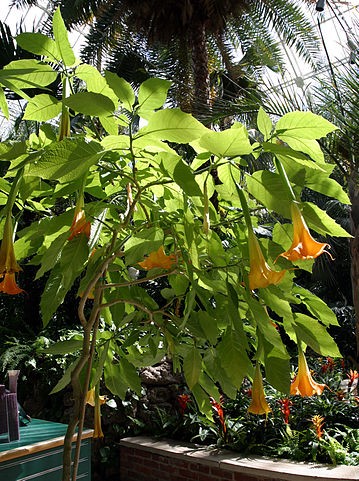“Angel’s Trumpets” typically refers to a group of flowering plants belonging to the Brugmansia genus. These plants are known for their large, trumpet-shaped flowers and are often grown as ornamental plants. Here’s a guide to unlocking the secrets of Angel’s Trumpets:
1. Botanical Overview:
- Angel’s Trumpets belong to the Solanaceae family, which also includes tomatoes, potatoes, and other nightshades.
- The scientific name for Angel’s Trumpets is Brugmansia.

2. Appearance:
- Large, pendulous flowers with trumpet-like shapes, giving them their common name.
- Flowers can come in various colors, including white, yellow, pink, and peach.
3. Fragrance:
- Many Angel’s Trumpets are known for their strong, sweet fragrance, especially in the evening. The scent is often more pronounced at night to attract pollinators.
4. Growing Conditions:
- Angel’s Trumpets are often grown as ornamental plants in gardens or as potted plants.
- They prefer well-draining soil, ample sunlight, and protection from strong winds.
5. Toxicity:
- All parts of Angel’s Trumpets are toxic if ingested. Care should be taken to keep them out of reach of children and pets.
6. Cultural Symbolism:
- In some cultures, Angel’s Trumpets symbolize beauty, mystery, and ephemeral nature due to their stunning but fleeting blossoms.
7. Use in Landscaping:
- Angel’s Trumpets are popular choices for landscaping due to their showy flowers and ability to attract hummingbirds and butterflies.
8. Medical Uses:
- In traditional medicine, certain cultures have used Angel’s Trumpets for various purposes, though extreme caution is advised due to their toxicity.
9. Psychoactive Properties:
- Some Angel’s Trumpets contain alkaloids with psychoactive properties. However, attempting to use them for recreational purposes is extremely dangerous and can lead to severe toxicity.
10. Winter Care:
- In colder climates, Angel’s Trumpets may need protection from frost. They can be grown as potted plants and brought indoors during the winter.
11. Pruning and Maintenance:
- Regular pruning can help maintain the shape of the plant and encourage more blooms. Be cautious when handling the plant and wear gloves due to its toxicity.
12. Propagation:
- Angel’s Trumpets can be propagated through seeds or cuttings. Propagation is relatively straightforward, making it easier for gardeners to cultivate new plants.
13. Disease and Pest Concerns:
- Keep an eye out for pests and diseases, and address them promptly. Common issues include aphids, spider mites, and fungal diseases.











